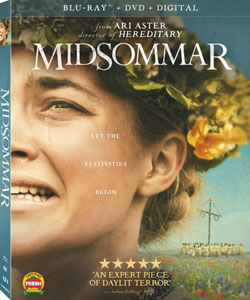By accident, I’m the target audience for the theatrical re-release of “Midsommar.” It was one of the summer movies I was most looking forward to, but it was in and out of theaters in a tiny window, so I missed it. But I didn’t want to wait till Oct. 8 for the home video release. Probably the real impetus for the re-release, which is a director’s cut nearly as long as “Avengers: Endgame,” is to give horror nerds a chance to further soak up the latest artistic, moody masterpiece from writer-director Ari Aster (“Hereditary”).
Aster emphasizes details
Aster doesn’t reinvent narrative structure or portrayals of troubled relationships, but he knows how to emphasize disturbing details. Here, he invents a commune in northern Sweden that starts off a little strange and ends up fully in WTF territory. Like a frog slowly boiling in water, a viewer doesn’t notice the transition because “Midsommar” is engrossing on so many levels (although the sure-to-become-infamous sex scene qualifies as a point where things ratchet up).
The relatively normal part of “Midsommar” is the relationship between college students Dani (Florence Pugh, my favorite actress) and Christian (Jack Reynor, whose Chris Pratt-style charisma I first noticed in an episode of “Electric Dreams”).

“Midsommar” (2019)
Director: Ari Aster
Writer: Ari Aster
Stars: Florence Pugh, Jack Reynor, Vilhelm Blomgren
In real life, usually only the couple themselves notices little things like one partner pulling away and another being in denial, but Aster nicely illustrates this. For example, when Christian invites Dani to join him on his Sweden trip with his friends, we’re wondering along with Dani: Did he always plan to invite her (as he claims), or is he inviting her because she’s upset that he didn’t tell her about the trip earlier?
Rounding out the group are serious anthropology student Josh (William Jackson Harper), wisecracker Mark (Will Poulter) and exchange student Pelle (Vilhelm Blomgren), who grew up at the commune and wants to show it off to his friends. Blomgren and several of the actors playing commune members are slightly off-center; I suspect English is not their first language. It adds to the naturalness of the nature-worshiping commune, but also to the unease of the proceedings.
“Midsommar” – which broadly reminds me of “The Village” if we’re going with the “Aster is the next Shyamalan” theory — features a lot of gorgeous long shots, many of which ask you to soak up symbolism. For example, an overhead shot shows the outdoor tables arranged in the shape of the letter “R.” Among Josh’s research materials is a book on Nazi symbols.
Images, symbols leave a viewer uneasy
It probably adds up to something concrete, but on my first viewing, it’s enough that these images and symbols leave me as uneasy as the commune’s visitors. They’re mostly allowed to wander around the grounds (with the exception of one mysterious barn), and occasionally they’ll see something crazily out of place, like a quilt depicting the sexual progression of a girl into a woman.

Josh and Christian speak about keeping an open mind as they document this reclusive culture for their dissertations. And indeed, as we see these people’s bizarre customs, we are encouraged to reflect on mainstream Western customs. Is the difference between what’s normal and what’s weird — what’s private and what’s public, what’s to be spoken and what’s to be unspoken, what’s a happy life moment and what’s a sad life moment — simply a matter of what we’re accustomed to?
If you can think of a taboo, it probably comes up in “Midsommar,” but not always in a shock-value way. As isolated as the commune is, everything these people do has an internal logic. For example, small populations face the possibility of high levels of incest and ultimately the destruction of their culture. But they have a strategy for combating that. These people are perhaps twisted, but they aren’t stupid.
That said, this is a really weird culture by standard reckoning, and “Midsommar” plays perfectly well as a critique of cults and the extreme aspects of religions. There’s a moment toward the end where a commune member experiences what he’s always wanted to experience (based on the doctrines he’s been led to embrace), and only when he experiences it does he finally question it. It’s a brief but harrowing moment that will keep you up at night.
Ultimately, “Midsommar” is a rare film that gets full marks yet I don’t know if I want to ever see it again. There probably aren’t a ton of moviegoers taking advantage of this re-release to see the bonus footage, and those who haven’t seen it yet might balk at the nearly 3-hour runtime (although, like “Endgame,” this is an engrossing 3 hours). But horror fans should at least rent “Midsommar” next month. The genre is rarely this artistic and intelligent.

